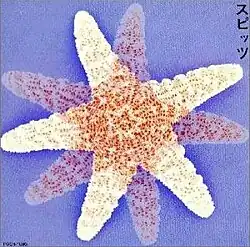Spitz (album)
| Spitz | ||||
|---|---|---|---|---|
 | ||||
| Studio album by | ||||
| Released | March 25, 1991 | |||
| Recorded | October 23 – November 20, 1990 | |||
| Studio | Key-Stone Studios, Smile Garage, Sound Inn | |||
| Genre | Post-punk | |||
| Length | 48:17 | |||
| Label | Polydor Records | |||
| Producer | Spitz, Nobuhiko Takahashi | |||
| Spitz chronology | ||||
| ||||
| Singles from Spitz | ||||
| ||||
Spitz is a studio album by Spitz, released via Polydor Records in 1991. It is the band's first major-label album. It peaked at number 60 on the Oricon Albums Chart.[1] In 2007, Rolling Stone Japan placed it at number 94 on its list of the "100 Greatest Japanese Rock Albums of All Time".[2]
Track listing
| No. | Title | Writer(s) | Japanese title | Length |
|---|---|---|---|---|
| 1. | "Ninoude no Sekai" | Masamune Kusano | ニノウデの世界 | 4:30 |
| 2. | "Umi to Pink" | Kusano | 海とピンク | 3:38 |
| 3. | "Bīdama" | Kusano | ビー玉 | 4:42 |
| 4. | "Gosenkounen no Yume" | Kusano | 五千光年の夢 | 2:42 |
| 5. | "Tsuki ni Kaeru" | Kusano, Tetsuya Miwa | 月に帰る | 4:26 |
| 6. | "Telebi" | Kusano | テレビ | 4:08 |
| 7. | "Tanpopo" | Kusano | タンポポ | 5:08 |
| 8. | "Shinigami no Misaki e" | Kusano, Miwa | 死神の岬へ | 3:44 |
| 9. | "Tonbi Tobenakatta" | Kusano | トンビ飛べなかった | 3:31 |
| 10. | "Natsu no Mamono" | Kusano | 夏の魔物 | 3:10 |
| 11. | "Umeboshi" | Kusano | うめぼし | 3:36 |
| 12. | "Hibari no Kokoro" | Kusano | ヒバリのこころ | 4:51 |
Personnel
Credits adapted from the liner notes.
Spitz
- Masamune Kusano – vocals, acoustic guitar, harmonica
- Tetsuya Miwa – electric guitar, acoustic guitar, electric/acoustic twelve-string guitar, classical guitar
- Akihiro Tamura – four-string bass guitar, eight-string bass guitar
- Tatsuo Sakiyama – drums, tambourine, cabassa, triangle, claves
Additional musicians
- Tsunehiko Yashiro – harmonium ("Bīdama"), ensoliq ("Tsuki ni Kaeru"), Farfisa organ ("Shinigami no Misaki e"), Hammond organ ("Hibari no Kokoro")
- Aska Kaneko – violin ("Umeboshi")
- Jun Takeuchi – violin ("Umeboshi")
- Shigeo Horiuchi – cello ("Umeboshi")
- Shinichi Horiuchi – cello ("Umeboshi")
- Jake H. Conception – bass clarinet ("Umeboshi")
Production
- Spitz – producer, art direction
- Nobuhiko Takahashi – producer
- Juli Kawai – recording engineer, mixing engineer
- Shinya Nakamura – additional engineer
- Jiro Takita – additional engineer
- Koreyuki Tanaka – additional engineer
- Shinji Kobayashi – additional engineer
- Takayoshi Yamauchi – additional engineer
- Reiko Miyoshi – mastering engineer
- Yoshiro Kajitani – art direction, design
- Michiko Arakawa – design
- Masao Torii – photography
- Takeo Ogiso – photography
- Yutaka Yoda – hair, make-up
- Mayumi Katayama – styling
- Yoshitomo Yoshimoto – graphic novel (1997 reissue)
- Stephen Marcussen – remastering engineer (2002 reissue)
- Yoichiro Yamazaki – sleevenotes (2002 reissue)
Charts
| Chart | Peak position |
|---|---|
| Japanese Albums (Oricon)[1] | 60 |
Release history
| Country | Date | Label | Format | Catalog number | Notes |
|---|---|---|---|---|---|
| Japan | March 25, 1991 | Polydor Records | CD | POCH-1080 | |
| July 7, 1997 | LP | POJH-1009 | Reissue | ||
| October 16, 2002 | Universal Music Group | CD | UPCH-1181 | Reissue, original recording digitally remastered | |
| December 17, 2008 | SHM-CD | UPCH-1671 | |||
| July 05, 2017 | LP | UPJH-9024 |
References
- ^ a b "スピッツ - スピッツ". Oricon. Retrieved October 25, 2017.
- ^ Lindsay, Cam (November 14, 2007). "Finally! "The 100 Greatest Japanese Rock Albums of All Time" Listed". Exclaim!. Retrieved October 25, 2017.